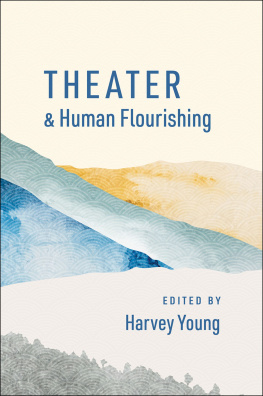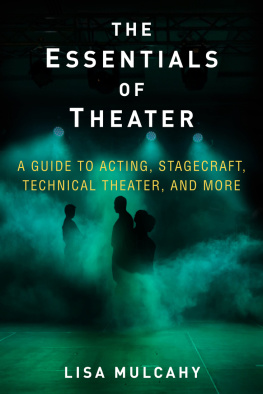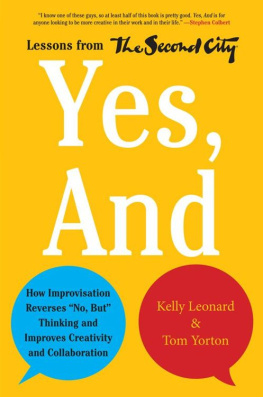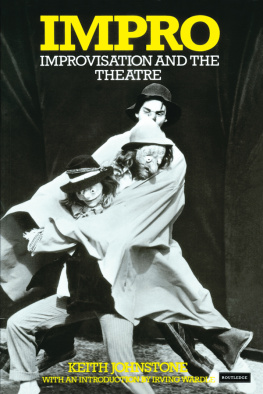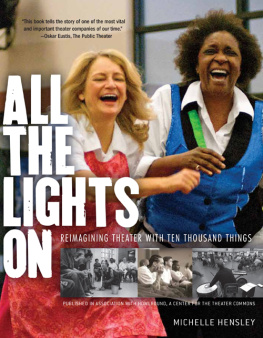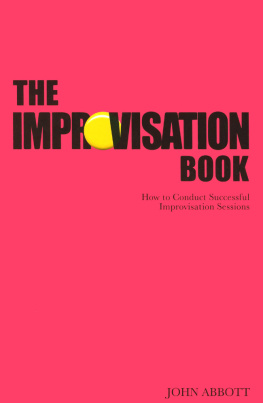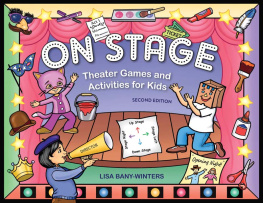

Barakaldo Books 2020, all rights reserved. No part of this publication may be reproduced, stored in a retrieval system or transmitted by any means, electrical, mechanical or otherwise without the written permission of the copyright holder.
Publishers Note
Although in most cases we have retained the Authors original spelling and grammar to authentically reproduce the work of the Author and the original intent of such material, some additional notes and clarifications have been added for the modern readers benefit.
We have also made every effort to include all maps and illustrations of the original edition the limitations of formatting do not allow of including larger maps, we will upload as many of these maps as possible.
IMPROVISATION FOR THE THEATER
A HANDBOOK OF TEACHING AND DIRECTING TECHNIQUES
By
VIOLA SPOLIN
ORIGINATOR OF THEATER GAMES
Table of Contents
Contents
DEDICATION
To Neva Boyd, Ed and all the YACs, and my sons Paul and Bill
ACKNOWLEDGMENTS
I wish to thank Neva L. Boyd for the inspiration she gave me in the field of creative group play. A pioneer in her field, she founded the Recreational Training School at Chicagos Hull House, and from 1927 until her retirement in 1941 she served as a sociologist on the faculty of Northwestern University. From 1924 to 1927 as her student at her house, I received from her an extraordinary training in the use of games, story-telling, folk dance, and dramatics as tools for stimulating creative expression in both children and adults, through self-discovery and personal experiencing. The effects of her inspiration never left me for a single day.
Subsequently, three years as teacher and supervisor of creative dramatics on the WPA Recreational Project in Chicagowhere most of the students had little or no background in theater or teachingprovided the opportunity for my first direct experiments in teaching drama, from which developed a non-verbal, non-psychological approach. This period of growth was most challenging, as I struggled to equip the participating men and women with adequate knowledge and technique to sustain them as teacher-directors in their neighborhood work.
I am also grateful for the insights I have had, at sporadic times throughout my life, into the works of Constantin Stanislavsky.
To my son, Paul Sillswho with David Shepherd founded the first professional improvisational theater in the country, the Compass (1956-1958)I owe the first use of my material, and I am grateful for his assistance in the writing of the first manuscript a dozen or so years ago and his experimental use of it at the University of Bristol while a Fulbright Scholar. From 1959 to 1964 he applied aspects of this system with actors at the Second City in Chicago. The final revision of this book could only take place after I came to Chicago, observed his work with his company, and sensed his vision of where it could go.
I wish to thank all my California students who nagged me over the years; and my assistant Robert Martin, who was with me during the eleven years of the Young Actors Company in Hollywood where most of the system was developed; and Edward Spolin, whose special genius for set design framed the Young Actors in glory.
My grateful thanks to Helene Koon of Los Angeles, who helped me through the second rewrite of the manuscript, and all my dear Chicago friends and students who helped in every way they could during the arduous task of completing the third and final draft of the manuscript.
Viola Spolin
Preface
The stimulus to write this handbook can be traced back beyond the authors early work as drama supervisor on the Chicago WPA Recreational Project to childhood memories of delightful spontaneous operas that were performed at family gatherings. Here, her uncles and aunts would dress up and through song and dialogue poke fun at various members of the family and their trials and predicaments with language and jobs as newcomers to America. Later, during her student days with Neva Boyd, her brothers, sisters, and friends would gather weekly to play charades (used as WORD GAME in this book), literally tearing the house apart from kitchen to living room as pot covers became breastplates for Cleopatra and her handmaidens and drapes from the window became a cloak for Satan.
Using the game structure as a basis for theater training, as a means to free the child and the so-called amateur from mechanical, stilted stage behavior, she wrote an article on her observations. Working primarily with children and neighborhood adults at a settlement-house theater, she was also stimulated by the response of school audiences to her small troupe of child improvisers. In an effort to show how the improvising game worked, her troupe asked the audience for suggestions which the players then made into scene improvisations. A writer friend who was asked to evaluate the article she wrote about these activities exclaimed, This isnt an articleits an outline for a book!
The idea for a book was put aside until 1945, when, after moving to California and establishing the Young Actors Company in Hollywood, the author again began experimenting with theater techniques with boys and girls. The creative group work and game principles learned from Neva Boyd continued to be applied to the theater situation in both workshops and rehearsal of plays. Gradually the word player was introduced to replace actor and physicalizing to replace feeling. At this time, the problem-solving and point-of-concentration approach was added to the game structure.
The training continued to develop the form that had appeared earlier in the Chicago Experimental Theaterscene improvisationalthough the primary goal remained that of training lay actors and children within the formal theater. The players created scenes themselves without benefit of an outside playwright or examples by the teacher-director while they were being freed to receive the stage conventions. Using the uncomplicated guiding structure labeled Where, Who, and What, they were able to put the full range of spontaneity to work as they created scene after scene of fresh material. Involved with the structure and concentrating upon solving a different problem in each exercise, they gradually shed their mechanical behaviorisms, emoting, etc., and they entered into the stage reality freely and naturally, skilled in improvisational techniques and prepared to act difficult roles in written plays.
Although the material has been drafted for publication for many years, its final form was reached after the author observed how improvisation works professionallyat the Second City in Chicago, the improvisational theater of her son, director Paul Sills. His further development of the form in use professionally brought new discoveries and the introduction of many newly invented exercises in her Chicago workshops. The manuscript underwent total revision to include the new material and to present the clearest use of the form for professional as well as community and childrens theater.
The handbook is divided into three parts. The first is concerned with the theory and foundations for teaching and directing theater, the second with an outline of workshop exercises, and the third with special comments on children in the theater and directing the formal play for the community theater.
The handbook is equally valuable for professionals, lay actors, and children. For the school and community center it offers a detailed workshop program. For directors of community and professional theater it provides insight into their actors problems and techniques for solving them. To the aspiring actor or director it brings an awareness of the inherent problems which lie before him.
Next page
![Viola Spolin Improvisation for the Theater: A Handbook of Teaching and Directing Techniques [1963 ed.]](/uploads/posts/book/406435/thumbs/viola-spolin-improvisation-for-the-theater-a.jpg)
